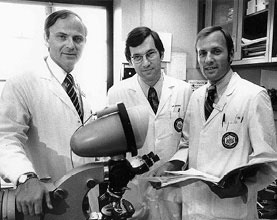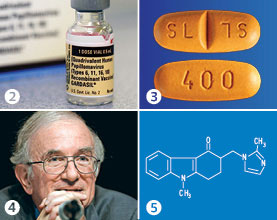Oct 28, 2014
To mark ASCO’s 50th anniversary, the Society called on the oncology community to select the five most pivotal advances in cancer research and patient care over the past 50 years. Now, with more than 2,000 votes cast, ASCO has announced the results on CancerProgress.Net, its interactive website on the history of progress against cancer.
The results offer a range of clinicalresearch advances, from cancer preventionto chemotherapy, molecularlytargeted therapy to supportive care.
 |
|
| Dr. Vincent T. DeVita, Jr. (center), with two other ASCO Past Presidents, Dr. George P. Canellos (1993-1994) and Dr. Robert C. Young (1989-1990), at the National Cancer Institute in the early 1970s. |
Voters selected these milestonesfrom a ballot of 32 advances drawnfrom CancerProgress.Net’s “MajorMilestones” timeline, which was developedunder the guidance of leadingoncologists. The ballot also allowedvoters to describe why they madetheir selection (see the below about “WhyThey Voted”).
Here are the results of the voteon the “Top 5 Advances in ModernOncology”
1. MOPP chemotherapy curesadvanced Hodgkin lymphoma
In 1965, Vincent T. DeVita, Jr., MD,FASCO, (ASCO Past President,1977-1978) and his colleagues atthe National Institutes of Healthdiscovered that combination chemotherapy—mechlorethamine, vincristine,procarbazine, and prednisone(MOPP)—induced long-term remissionsin over half of adults with Hodgkinlymphoma. The discovery sparkedthe first hope that advanced cancerscould be cured with drug treatmentand paved the way for 90% cure ratesin patients with this disease today.
2. HPV vaccine approved toprevent cervical cancer
The first human papillomavirus (HPV)vaccine—approved in 2006—brought100% protection against the twostrains of HPV known to cause mostcervical cancers. Widespread vaccination,if fully implemented, coulddrive dramatic reductions in cervicaland other HPV-related cancers in theUnited States and worldwide.
3. Imatinib transforms treatmentof chronic myelogenousleukemia
(4) ASCO Past President (2000-2001) Lawrence H. Einhorn, MD, FASCO The rapid U.S. Food and Drug Administrationreview and approval ofimatinib in 2001 transformed treatmentfor most patients with chronicmyelogenous leukemia (CML). Thiseasy-to-take pill turned a diseasewith no long-term survivors into onewith five-year survival rates of almost90%. It also heralded a new era ofresearch on molecularly targetedanti-cancer drugs. Today, over 60 ofthese medicines are available.
4. PVB chemotherapy curestesticular cancer
In 1977, Lawrence H. Einhorn, MD,FASCO (ASCO Past President,2000-2001) and colleagues showedthat a new three-drug combinationchemotherapy regimen—cisplatin,vinblastine, and bleomycin (PVB)—produced complete remissionsfor 70% of men with aggressivetesticular cancer. Prior chemotherapytreatments worked in just 5% of men.This discovery, coupled with latermultidisciplinary advances, madetesticular cancer treatment one ofoncology’s biggest success stories.
5. Powerful anti-nausea drugsdramatically improve manypatients’ quality of life
The introduction of ondansetron in1991, together with other supportivecare advances, dramatically changedthe experience of cancer treatmentfor patients. These drugs not onlybrought relief from intense, treatmentinducednausea and vomiting, but alsomade it possible for patients to avoidonce-routine hospital stays, completetheir full course of treatment, and livelonger and better lives overall.
These results not only demonstratethe remarkable progress achievedin cancer research since ASCO’sfounding, but also the payoff offederal investment in clinicalresearch: NIH research grants playeda role in many of the discoveries thatmade the Top 5.
For more information on the Top 5,including historic photos and morecomments from people who voted,visit CancerProgress.Net/Top5.
Why They Voted: Comments from the Oncology Community
1965: MOPP chemotherapy cures Hodgkin lymphoma
“This was the clearest proof of concept that cancer was/is curable. It gave greatimpulse to therapeutic research that ultimately improved outcomes in breast,colon, kidney cancer, the leukemias, and most childhood malignancies.”
2006: HPV vaccine approved to prevent cervical cancer
“This advance—if broadly adopted—could lead to the total eradication ofcervical cancer globally as well. . . . Millions could be saved.”
2001: Imatinib transforms treatment for CML
“[Imatinib] not only revolutionized CML, but cancer therapy in general. Atargeted agent directed at a cancer-causing gene—it represents the dawn oftargeted therapy for cancer.”
1977: PVB cures men with testicular cancer
“Took the most lethal cancer for young men to the most curable.”
1991: Powerful anti-nausea drugs alleviate major side effect of cancertreatment
“[Antiemetics] permit millions of patients to receive full cancer regimens,delivered in a timely fashion . . .many even continue to work and lead highfunctioninglives during treatment.”

